Prev Page--Scylliidae || Next Page--Pycnodontidae
Lamnidae
The Lamnidae comprise the largest and most voracious of the sharks, represented by a number of species in the oceans of the present time. They are elongated fishes, the dorsal fin without spine; there is no nictitating membrane to the eye, and the gill openings are wide. The teeth are solid in the adult, and are 300 or more in number. The teeth are found very commonly in the Cretaceous deposits of Kansas, as elsewhere, usually scattered singly, though occasionally found more or less connected by the calcified cartilage of the, jaws in several rows. Owing to the great variation of size and shape of the teeth in the same individual, it is often difficult or impossible to correctly determine the forms. Doctor Eastman has recently figured and described the nearly complete dentition of Isurus mantelli, the most common species of the family in Kansas. Doubtless similar variations will be found in the different species of the other genera of this family.
Isurus
This genus differs from Lamna only in the prevailing absence of the lateral denticles of the teeth. The teeth are large. The genus occurs from Jurassic to the present time.
Isurus mantelli. Plate XXXI, figs. 41-46; plate XXXII, figs. 2-2m.
Oxyrhina mantelli (Geinitz) Agassiz, Poiss. Foss., III, p. 282, pl. XXXIII, ff. 1-5, 7-9; Eastman, Paleontographica, XLI, pp. 149-492, pll. XVI-XVIII (where additional extensive synonymy will be found); Woodward, Proc. Geol. Assoc., XIII. p. 196--Cenomanian, Senonian and Turonian of Europe; Kansas, Texas, New Jersey, Alabama, Colorado, etc.
Oxyrhina extenta Leidy, Ext. Vert. Fauna, p. 302, pl. XVIII, ff. 21-25.
Plate XXXI, Fig. 41-46--Isurus mantelli Agassiz, nearly natural size.
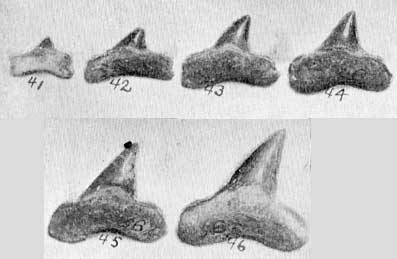
Plate XXXII, Fig. 2-2m--Isurus mantelli, from a single individual.
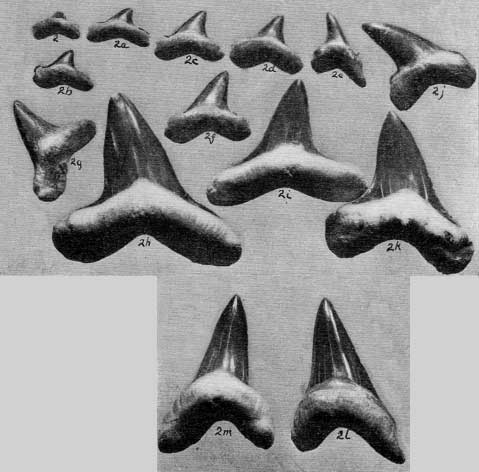
"Moderate-sized, stout, three-cornered teeth; the crown on the outer side nearly flat, with one or more vertical wrinkles; on the inner side, lightly convex and smooth; root long, thick, low, moderately deeply furcate, usually obtuse at the ends, and on both sides more or less flattened." [Eastman, l. c.]
This species is very common in the Kansas Niobrara, in fact, the most common of all, and not infrequently it is represented by many associated teeth. From the plates, and from Eastman's figures, it will be readily identified in all its forms.
Lamna
Some of the following species may belong to Odontaspis, which can hardly be distinguished by the teeth alone, differing only in the relatively less high and less subulated character of the anterior ones, and in the usually larger size of the lateral denticles.
Lamna appendiculata. Plate XXVI [sic. XXXII], figs. 3-3c; plate XXXI, figs. 47-49.
Otodus appendiculatus (Roemer) Agassiz, Poiss. Foss., in, p. 279, pl. XXXII, ff. 1-25; Davis, Trans. Roy. Dubl. Soc., IV, p. 402, pl. XLI, ff. 1-11.
Lamna appendiculata Woodward, Cat. Foss. Fishes Brit. Mus., I, p. 393; Proc. Geol. Assoc. XIII, p. 196; Williston, cf. cit. 37--Senonian, Cenomanian, Turonian (?), Danian of Europe, Niobrara of Kansas, and Greensand of New Jersey.
Plate XXXII, Fig. 3-3c--Lamna appendiculata.

Plate XXXI, Fig. 47-49--Lamna appendiculata Roemer, nearly natural size.
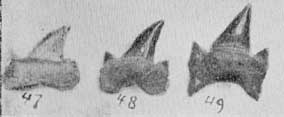
"Teeth robust, with a thick root, having a much flattened postero-inferior face, the nutritive foramen not in a groove. Outer face slightly convex or flat, often with a few indefinite vertical folds on the basal half; inner side of crown markedly convex, smooth; cutting edges prominent; a single pair of lateral denticles, broad, but pointed. Anterior teeth narrow and upright; lateral teeth much inclined backward, the anterior teeth much more arcuate and longer than the posterior ones." [Woodward, l. c.]
Several teeth from the Niobrara chalk agree sufficiently well with the foregoing description, and especially with Woodward's figures, to permit their allocation here. They are somewhat broader than the specimens figured by Woodward. Two of the specimens differ markedly from the others in having the base flatter and the roots much less prolonged downward, the notch of the base shallower and shorter. Another tooth from the base of the Benton, in the conglomerate containing the specimens of Corax curvatus and Ptychodus janewayii, agrees well with these last specimens and apparently belongs to the same species, if distinct. Their resemblance to Odontaspis kopingensis Davis likewise cannot be denied, but the lateral denticles are more triangular in shape.
Lamna sulcata. Plate XXIV, figs. 1-1b.
Otodus sulcatus Geinitz, Char. Schicht. u. Petriffact, saechs-boehm Kreideb. 5, pl. IV, f. 2.
Otodus divaricatus Leidy, Ext. Vert. Fauna, p. 305, vol. XVIII, ff. 26-28; Cope, Cret. Vert., p. 295.
Lamna sulcata Woodward, Cat. Foss. Fishes Brit. Mus., I, p. 398 (where additional synonymy will be found); Proc. Geol. Assoc., XIII, p. 197; Williston, cf. cit. 37 - Cenomanian and Turonian, England, France, Belgium, Saxony. Bohemia; Senonian, England; Cretaceous, Texas, (Leidy); Jewell County, Kansas, (Cope); Mississippi (Cope).
Plate XXIV, Fig. 1-1b--Otodus sulcatus Geinitz, after Leidy, nearly natural size.
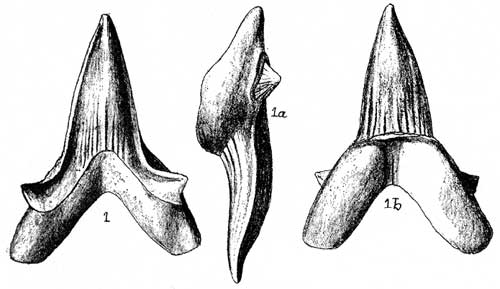
"Teeth very robust, the crown sometimes attaining a height of nearly 50 mm. Outer face of crown slightly convex, generally uneven; both the inner and the outer faces with more or less prominent series of vertical wrinkles near the base, usually irregular. A single pair of large, acuminate lateral denticles, slightly divergent, often incompletely separated from the principal cone. Root with a considerable inward prominence immediately below the base of the crown." [Woodward, l. c.]
"A name given to very large, robust teeth with vertically wrinkled crown and slightly divergent acuminate lateral denticles. There are specimens in the British Museum from undetermined horizons in the chalk of Kent, Surrey, and Sussex." [Woodward.]
This species is unknown to me. Its occurrence in Kansas is given on the authority of Cope. The horizon is evidently the Benton.
Lamna mudgei.
Lamna mudgei Cope, Cret. Vert., p. 207, pl. XII, ff. 11, 12; Williston, cf. cit. 38--Niobrara of Kansas, Greensand of New Jersey.
"Indicated by three teeth from the Niobrara epoch of Kansas and one from the Greensand No. 4, from New Jersey. These teeth are rather stout, especially at the base, and the crown is not very elongate. The root is excessively protuberant, projecting horizontally beyond the convex side, and flat or truncate below the protuberance. The enamel is entirely smooth. Length, 14 mm."
This species is unknown to me, or unrecognizable from the description and figures of the mutilated type specimens.
Lamna macrorhiza
Lamna macrorhiza Cope, Cret. Vert., p. 297, pl. XLII, ff. 9, 10; Woodward, Cat. Foss. Fishes, Brit. Mus., I, p. 399; Williston, cf. cit. 38 - Niobrara of Kansas; Albian, of England; Cenonian, of S.E. Russia (Woodward).
"Teeth of small size, elevated though robust, the maximum total height being about 25 mm. Outer coronal face flat, or nearly so, with a faint median longitudinal elevation, and often a few folds at the base; inner coronal face very convex, smooth; cutting edges sharp; a single pair of relatively large, narrow, acuminate lateral denticles, divergent, also often marked at the base by minute vertical folds; root with a prominent inward projection below the base of the crown; nutritive foramen in a groove."
The above description by Woodward is drawn from a European specimen, while the type described and figured by Cope is from Ellis County, Kansas, probably Niobrara. I do not know the species.
Lamna (Odontaspis?), sp. Plate XXX, fig. 5.
Lamna (Odontaspis?), sp., Williston, cf. cit. 38.
Plate XXX, Fig. 5--Lamna, sp., from Kiowa shales, enlarged one-half.
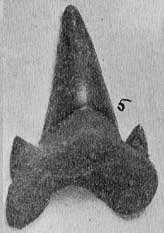
A single tooth from the Lower Cretaceous (Kiowa shales, Clark County), resembles the figure of Odontaspis kopingensis Davis, as figured by that author [Trans. Roy. Dubl. Soc., IV, XXXVI, figs. 27, 28.] except that it is smaller and has the base rather more prominent, more triangular, and more pointed. The tooth has also resemblance to Lamna appendiculata, but the denticles are stouter (compare Woodward.) [Proc. Geol. Assoc., XIII, pl. VI, fig. 26.] Height of crown, 15 mm; width of base, 18 mm; width of base of crown, 9 mm; distance between points of denticles, 14 mm.
Lamna, sp. Plate XXX, fig. 6.
Lamna, sp., Williston, cf. cit. 39.
Plate XXX, Fig. 6--Lamna, sp., from Kiowa shales, enlarged one-half.
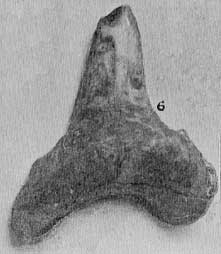
A somewhat injured tooth, of larger size than the last, differs in having a larger and stouter base, the inner projection in the middle of the latter stouter and broader, and the lateral denticles smaller and more obtuse. Height of tooth (approximately), 32 mm; width of base of crown, 12 mm; width of base of tooth, 25 mm.
One specimen, Kiowa shales, Clark County.
Lamna quinquelateralis.
Lamna quinquelateralis Cragin, Colo. Coll. Studies, v, p. 189; Williston, cf. cit. 39.
"The specific name quinquelateralis is applied to a species of shark whose vertebrae differ from all others of which I have any knowledge. The type vertebra is short, much broader than high, shallow-cupped, and more or less sharply pentagonal ended.
"Measurements: Height, 20 mm; length, 12 mm; breadth, 12 mm. The two upper angles measure each about 130 deg.; either lateral angles about 105 deg.; the lower angle is broad and rounded.
"Occurrence: A single vertebra of this form was found by the writer at Belvidere, Kan., with the above-described remains of Plesiochelys, in the upper part of No. 4 of the Belvidere section."
Possibly this vertebra belongs with one or the other of the above-described teeth from these same deposits, but the correlation cannot be made until the teeth and vertebrae are found associated, which may be long hence.
Scapanorhynchus.
Rhinognathus Davis, Trans. Roy. Dubl. Soc. (2), III, p. 480.
Scapanorhynchus Woodward, Cat. Foss. Fishes Brit. Mus., I, p. 351, (1889).
? Mitsukurina Jordan, Proc. Calif. Acad. Sci. Zool., I, (1898); Amer. Nat., XXXIV, p. 234.
The genus Scapanorhynchus, first proposed by Davis under a preoccupied name, has been more closely defined by Woodward. The teeth themselves cannot in many cases be generically distinguished from those of Odontaspis, under which name some were originally described.
Recently Doctor Woodward [Amer. Mag. Nat. Hist., III, p. 487 (1899).] has identified a modern genus of sharks, from the deep sea off Yokohama, Japan, with this supposedly extinct type--Mitsukurina Jordan.
Possibly the positive identification is premature, but there seems to be no doubt of the close relationship of the two forms, at least.
Scapanorhynchus rhaphiodon. Plate XXVI, fig. 4; plate XXXII, fig. 5.
Lamna (Odontaspis) rhaphiodon Agassiz, Poiss. Foss., III, p. 296, pl. XXXVII-A, ff. 12-16.
Scapanorhynchus rhaphiodon Woodward, Cat. Foss. Fishes Brit. Mus., I, p. 353 (where additional synonymy will be found); Proc. Geol. Assoc. XIII, p. 196--Cenomanian, Russia and Galicia: Cenomanian and Turonian, France, Saxony, and Bohemia; Cenomanian-Senonian, England; Upper Cretaceous, S. India; Upper Cretaceous of Texas, Mississippi, New Jersey; Benton Cretaceous of Kansas.
Lamna texana Roemer, Kreideb. von Texas, p. 29, pl. I, ff. 7; Leidy, Rep. U.S. Geol. Surv., I, p.304, pl. XVIII, ff. 46-50; Cope, Cret. Vert., p. 296.
Plate XXVI, Fig. 4--Scapanorhynchus rhaphiodon Agassiz, natural size.
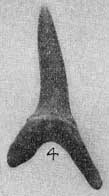
Plate XXXII, Fig. 5--Scapanorhynchus rhaphiodon Agassiz.

Teeth of considerable size, slender, the anterior ones without lateral denticles; inner coronal face conspicuously and finely striate.
A number of teeth before me from the Cretaceous of New Jersey and one from the Benton Cretaceous of Kansas agree fairly well with the figures given by Leidy of specimens from Mississippi, New Jersey, and "from near the mouth of Vermilion creek, in Kansas," and which agree with those from Texas called Lamna texana by Roemer.
The specimens agree so well with the European species, especially as figured by Woodward (l.c.; I have no European specimens for comparison), that I think there cannot be much doubt of their identity, a conclusion suggested by Woodward.
The Kansas specimen described by Leidy was said to have been obtained by Hayden from a "gray sandstone from near the mouth of Vermilion river." The Vermilion in Kansas runs its whole length through the Carboniferous in eastern Kansas; nor do I think there is any gray sandstone (necessarily Dakota Cretaceous) in the state which will yield these teeth. In all probability the specimens did not come from this state. However, a specimen in our collection agreeing with the species was obtained in the state, and probably from the Benton, though possibly from either the Niobrara or Fort Pierre.
Corax
The genus Corax is confined wholly to the Cretaceous, and is yet incompletely known. Its distinction from Galeocerdo, under which name some of its species have been described, is based upon the solidity of the teeth--those of Galeocerdo have a hollow cavity within. The teeth are small, compressed, more or less triangular, with marginal serrations, though this character may be more or less wanting in young individuals. They vary not a little in shape in the same individual. In some the crown is nearly bilaterally symmetrical, but they more usually have the crown directed more or less obliquely backward, the anterior margin convex, the posterior more or less straight and angulated.
Three species of the genus are known in England--C. falcatus, C. pristodontus, which is hardly distinct, and C. affinis. In addition, C. antiquus Desl., C. incisus Egert., C. laevis Gieb. and C. pygmaeus Munst. have been described from Europe, and C. crassidens Cope and C. hartvelli Cope from the United States.
Corax falcatus. Plate XXXI, figs. 1-40; plate XXXII, figs. 1-1l.
Corax falcatus Agassiz, Poiss. Foss., in, p. 226, pl. XXVI, f. 14, XXVI-A, ff. 1-15; Woodward, Cat. Foss. Fishes Brit. Mus., I, p. 424 (where additional synonymy will be found); Proc. Geol. Assoc., XIII, p. 198, pl. VI, ff. 13-15--Cenomanian and Turonian of England, France, Switzerland, Saxony, Bohemia, Galicia, and Russia; Senonian of England and France; Cretaceous of Texas, New Jersey, and Mississippi; Niobrara of Kansas.
Galeocerdo falcatus Leidy, Ext. Vert. Fauna West. Terr., p. 301, pl. XVII, ff. 29-42.
Plate XXXI, Figs. 1-40--Corax falcatus Agassiz, about nine-tenths natural size; isolated teeth from many individuals.
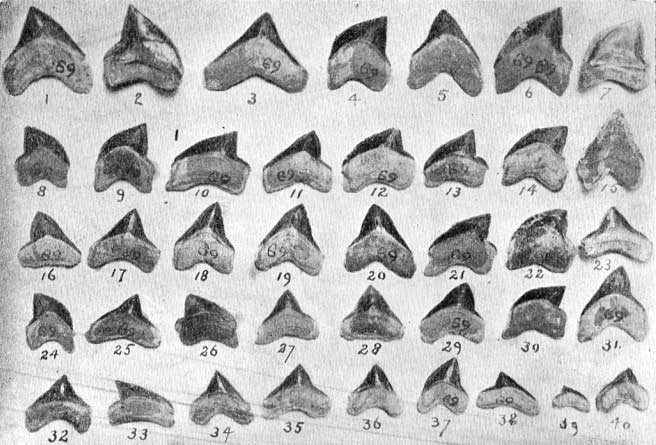
Plate XXXII, Figs. 1-11--Corax falcatus Agassiz, from a single individual.
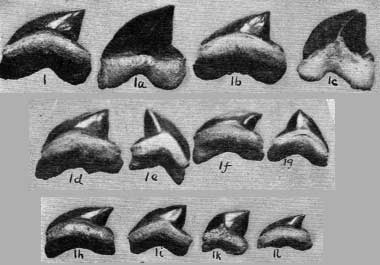
The very variable shape of the teeth referred to this species will be seen in plate XXXI, figs. 1-40. Possibly the specimens there figured represent distinct species. C. (Galeocerdo) crassidens Cope seems to be represented by fig. 24, and C. (Galeocerdo) hartvelli Cope [Cret. Vert., p. 244.] by fig. 23. Possibly this species also includes C. pristodontus and C. lindstromi, both of which seem to be imperfectly differentiated from C. falcatus at present.
In plate XXXIII, figs. 1-1l, are shown a number of teeth pertaining to a single individual and found associated with many others, by Mr. Martin, in the Niobrara Cretaceous of the Smoky Hill Valley. Isolated teeth of this species are the most abundant of the selachian teeth in the Niobrara of Kansas. Only in very few instances have many teeth been found associated, so that it is yet impossible to fully understand the dentition. The species occurs rarely, if at all, in the lower Niobrara horizons, where those of Isurus and Ptychodus are the most abundant.
Corax curvatus, n. sp. Plate XXX, figs. 7, 8.
Two specimens from the same block which yielded those of Ptychodus janewayii and Lamna species, antea, seem evidently specifically distinct from the foregoing. These teeth, while not differing much in outline from certain ones referred to C. falcatus, show a marked variance in structure. In C. falcatus the outer surface of the tooth stands out but very slightly. In C. curvatus the crown is attached to the root very obliquely, so that when resting upon a plane the tooth forms a high arch, touching only by the extreme tips of the roots and crown. The inner surface, also, is very much more uneven and convex, the crown separated from the root by a marked, narrow, transverse ridge, which is scarcely indicated in the teeth of C. falcatus. Altitude, 8 mm; greatest width, 14 mm; horizon, lower or lowermost Benton of Ellsworth County.
Leptostyrax
Williston, Kans. Univ. Quart., IX, p. 42, 1900
Leptostyrax bicuspidatus. Plate XXIV, figs. 15, 15a; plate XXVI, fig. 7.
Leptostyrax bicuspidatus Williston, cf. cit. 42.
Plate XXIV, Figs. 15, 15a--Leptostyrax bicuspidatus Willist., natural size.
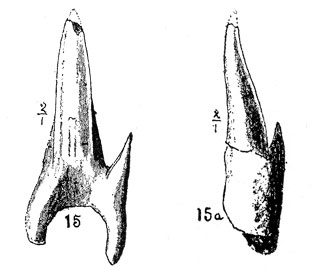
Plate XXVI, Fig. 7--Leptostyrax bicuspidatus Willist., enlarged.
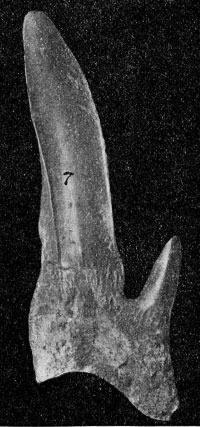
Principal cusp long and slender, flattened upon the outer side, with sharp, smooth edges and a median convexity in the middle of the flattened surface; for the most part convex longitudinally, gently concave before the apex. Inner surface strongly convex from side to side, concave on the lower half longitudinally, gently convex on the upper part. A single denticle present, slender, flattened cylindrical, with an anterior and posterior carina; it arises below the base of the main cusp, and is directed more outwards, its inner surface concave longitudinally. Immediate base of crown of both main cusp and denticle with short ridges. Base of tooth short, truncate (?) below the main cusp, prolonged downward below the denticle. Length of main cusp, 19 mm; width of same at base, 5 mm length of denticle, 5 mm; width of same at base, 2 1/2 mm; height of tooth, 26 mm; width of base, 10 mm.
A small tooth of the same form found with this has a total length of 14 mm. The base is deeply emarginate below, with two slender roots; that below the denticle the longer. Mentor beds, 4 1/2 miles southwest of Marquette, Kansas.
U.S. Nat. Mus. No. 1979.
Prev Page--Scylliidae || Next Page--Pycnodontidae
Kansas Geological Survey, Volume V1, Cretaceous Fishes
Comments to webadmin@kgs.ku.edu
Web version July 2004. Original publication date 1900.
URL=http://www.kgs.ku.edu/Publications/Bulletins/Vol6/03_lamn.html